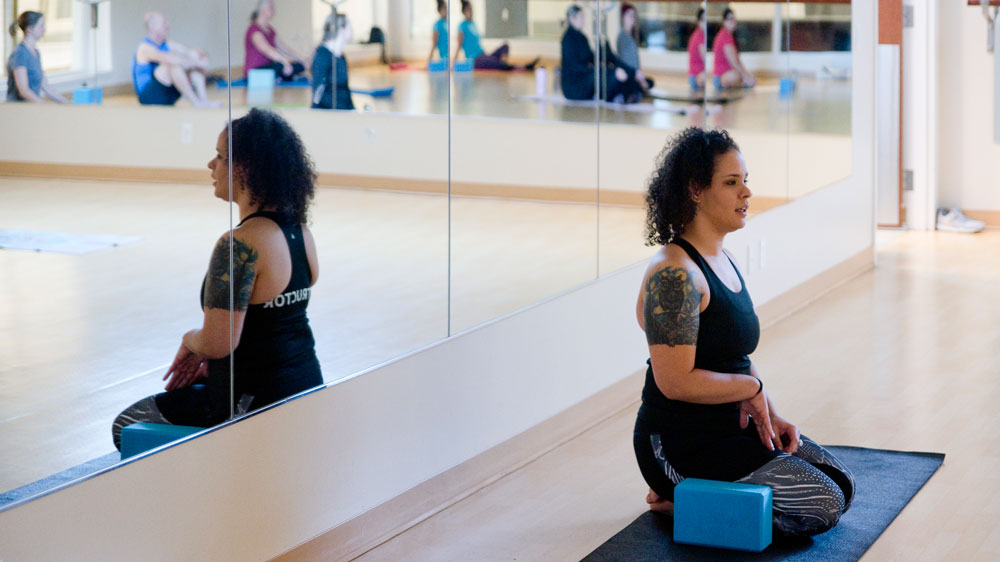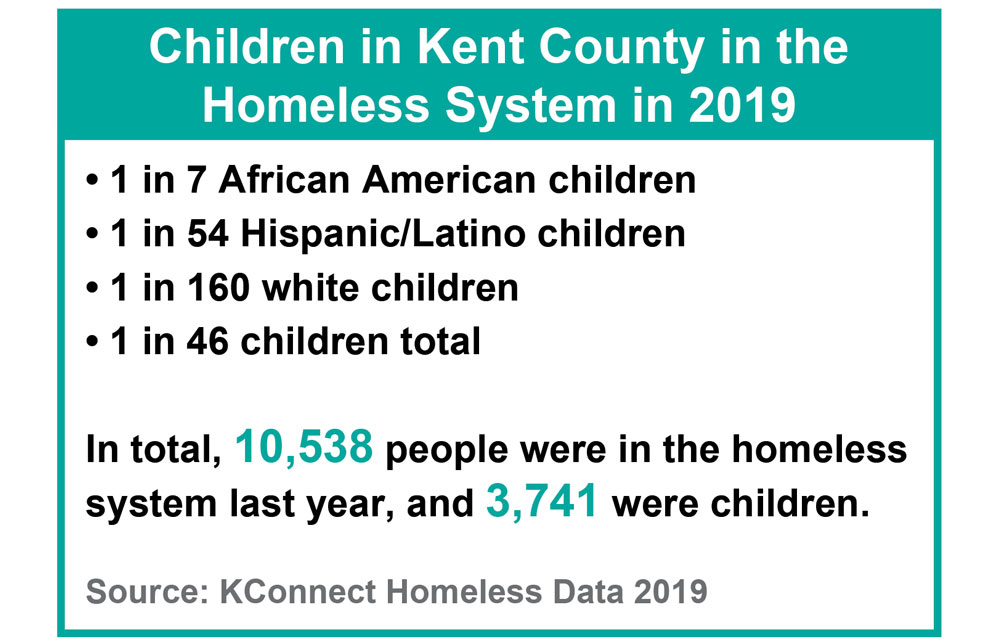For much of her life, Kayla Morgan has faced uncertainty about where she would lay her head down at night.
As a teenager, she attended a different high school each school year, moving from foster home to foster home in the West Michigan area. As an adult she lived in different temporary housing arrangements for two years with her children.

Now, the activist, owner of Resilient Roots Yoga, and mom of three elementary-age children enrolled in Grand Rapids Public Schools is working to change the trajectory of people of color struggling to find stable and affordable housing.
“I think there needs to be more representation of people of color in higher management positions and at decision-making tables,” Morgan said. “I think Grand Rapids has to acknowledge that it’s not the best place to live for everybody.”
Morgan is a “lived experience” expert who works with KConnect, a team of community stakeholders working together to address issues affecting children, youth and families.
In that role, Morgan talks about the impact of trauma and generational poverty on her life, and how she turned to abusive relationships in hopes of having a permanent place to live. She talks about the frustration of hard-to-navigate systems, of policies that keep people oppressed and how few good options exist for low-income people looking for places to live.
In the 11 years since she aged out of the foster care system, Morgan has continued to relocate frequently due to financial situations and other life circumstances. She and her children spent many months homeless, often sleeping at friends’ houses.
People of Color Disproportionately Impacted
Morgan’s voice is providing personal testimony to the fact that there’s major disproportionality by race when it comes to people affected by homelessness. One in seven African American children in Kent County — 2,658 in all — were in the homeless system in 2018, according to data from K-Connect.
The disparity is not just in African Americans. Out of all children in the county, one in 46 were in the homeless system in 2018. But for Hispanic/Latino children the proportion was one in 54, while for white children it was one in 160. In total, 10,538 people were in the homeless system last year, of which 3,741 — 33 percent — were children.
“These numbers are crushing and yet, these numbers only reflect the children we know about,” said Brandy Lovelady-Mitchell, Kent ISD director of Diversity, Equity and Inclusion and member of KConnect’s Housing Security Design Team. “There are likely others who are impacted by homelessness whom our system knows nothing about yet. Our community needs to know the magnitude of the demand and the urgency.”
This data point amplifies the reality that many black people are struggling in Kent County, Lovelady-Mitchell said, adding, “Please hear me when I say it is not because of any deficit in black people.”
Education, health, employment rates, economic development and opportunities all factor into generational wealth, and there are major disparities in these areas by race, she said.
“Each of (those) elements intersect with housing and the way that race influences these systems. I see the faces behind those numbers which brings me to my knees. One child is too many.”
Diana Sieger, president of the Grand Rapids Community Foundation and KConnect board member, said seeing the data is “horrific.”
“It’s important to look at the data; it’s also important to feel what this means,” Sieger said. “We need to acknowledge systemic racism is really at the root of all of this, particularly when we look at the statistics of homeless children.”
The data includes literally homeless people (without a fixed, regular nighttime residence or living in shelters, hotels and motels) or people who are facing the imminent threat of losing their residence. (KConnect data includes infants and children not old enough for school, so differs from McKinney-Vento Act data, which includes only children enrolled in school that have been reported as homeless.)
Huge Gaps in Income
Income helps explain the disproportion. According to KConnect data, in Kent County, average monthly earnings for white workers in the second quarter of 2018 was $4,411, compared to $2,840 for black workers. That’s $25.45 per hour compared to $16.38 per hour for a 40-hour work week.
The numbers show paying for basic needs is difficult for many families. The basic annual cost of living for a family of four in 2017, according to the ALICE report, completed by the Michigan Association of United Ways, was $61,272 — up 27 percent from 2010 and equal to an hourly wage of $30.64.
“Taking $2 million and buying houses that could be passed down from generation to generation is a much better solution that creating small units and packing people together where there’s no space to grow.”
— Kayla Morgan, Grand Rapids mom and lived experience expert for KConnect
In terms of housing, Sieger said there is much more need than federal subsidies available to help very low-income families pay for housing in Grand Rapids. She said she is grateful data is being scrutinized, and hopes it leads to framing housing as a larger community problem and then yield new ways of addressing it.
Lovelady-Mitchell also struck a hopeful note.
“I believe Kent County is rich with people who care, rich with resources and hopefully rich with people who are invested in inclusive growth,” she said. “I believe our region will find a way to change this sooner versus later for the sake of all of our babies, especially the one in seven black babies who are under this burden.”

Kayla Morgan uses yoga as a way to reduce the effects of stress and trauma (photo by Dianne Carroll Burdick)
Housing Struggles Continue
Kayla Morgan continues to face difficulty in finding housing she can afford that is safe and adequate for her children and mother, who needs care due to health problems.
“My kids don’t have a yard; they can’t go outside and play,” she said. “Going in the hallway, I feel like it’s not safe. There are liquor bottles lying around. … There are people fighting.”
She was in the process of moving from one Grand Rapids nonprofit-owned apartment to another, a place where she was on the waiting list for a full year. She paid more than $1,500 for deposit and first month’s rent on a new lease.
“I do feel like we are still not housed by choice,” she said, meaning she has always had to take what she can get and what’s available. “It’s whoever calls you back. We weren’t even able to look at these apartments before we applied; it was basically you take what you can get or leave.”
When walking through the Northeast side apartment for the first time, she discovered roaches, exposed outlets, dirty floors and other areas in need of repair. She said she hoped to get her money back and search for something else, but worried she would have to move in with others again. As of early December she had decided to stay in the apartment.
“I see the faces behind those numbers which brings me to my knees. One child is too many.”
— Brandy Lovelady-Mitchell
Morgan, who said she does not receive rental assistance or Section 8 Housing Vouchers, doesn’t believe more government-subsidized units is the best answer. She wants economic amends for past injustices to be part of the conversation.
“We wouldn’t choose to live in projects, which is what they are. They are building projects and putting us there not by choice.
“Taking $2 million and buying houses that could be passed down from generation to generation is a much better solution than creating small units and packing people together where there’s no space to grow.”
Morgan said the number of homeless children of color is unacceptable.
“It makes me angry. It makes me sad and I think someone needs to apologize. Someone needs to take accountability,” she said. Systems need to change, she said.
“I think there have to be more discussions around antiracism policies and procedures beyond lip service, with succession planning and anti-racism being in the DNA of every organization.”
Morgan hopes to one day to have a home that she can truly call her own.
“I would love for my kids to have one place they can live in until they move out and we don’t have to move again,” she said.
“I would love to have a house that I own where my kids could play outside and it’s in a safe neighborhood and it’s close to their school.”










